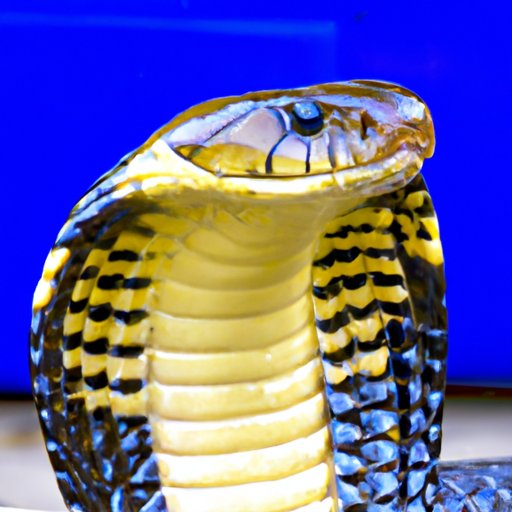Introduction
Cobras are a group of venomous snakes found throughout tropical regions around the world. They are renowned for their distinctive hoods and intimidating hissing sound. But how do cobras actually work? This article will explore the anatomy and physiology of cobras, the mechanics of venom delivery, the neurotoxic effects of cobra venom, the role of cobras in ecosystems, and the impact of human interaction on cobras.
Exploring the Anatomy and Physiology of a Cobra
Cobras come in a variety of shapes, sizes, and colors. Depending on the species, they can range from 2 feet to 18 feet long. The most famous cobra is the king cobra, which can reach up to 18 feet long and weigh up to 20 pounds. Other types of cobras include the spitting cobra, the Indian cobra, and the Egyptian cobra.
Cobras have several unique physical characteristics that make them well-adapted for their environment. Their eyes are large and sensitive, allowing them to detect even the slightest movement. Their tongues are long and forked, enabling them to detect odors in the air. And their fangs are hollow, allowing them to inject venom into prey or predators.
Cobras are also adept at reproduction. Female cobras lay between 20 and 50 eggs at a time, which hatch after about 60 days. The baby cobras are then left to fend for themselves, as the mother does not provide any parental care.
Cobras are carnivorous animals and feed primarily on small mammals, birds, and other reptiles. They hunt by lying in wait for their prey and then striking quickly with their venomous fangs. Cobras can consume up to one-third of their body weight in a single meal.

Investigating the Mechanics of Cobra Venom Delivery
Cobras possess two venom glands located in the back of their heads. These glands produce venom, which is a mixture of proteins and enzymes. The venom is then transported through a series of ducts and vessels to the cobra’s fangs, which act as delivery systems. When a cobra bites its prey, the venom is injected directly into the bloodstream, causing paralysis and death.
The amount of venom delivered by a cobra depends on the size of the snake and the target of the bite. For example, a king cobra can deliver more than 200 milligrams of venom in a single bite, while a smaller species may only deliver 10 milligrams. The venom is typically fatal to humans and other animals, but there are some species of cobras whose venom is less toxic.

Examining the Neurotoxic Effects of Cobra Venom
Cobra venom is composed primarily of neurotoxins, which are proteins that interfere with nerve signals in the body. When injected into the bloodstream, these neurotoxins can cause paralysis, respiratory failure, cardiovascular collapse, and even death. The symptoms of cobra envenomation vary depending on the species of cobra and the amount of venom injected. Common symptoms include severe pain, swelling, weakness, and difficulty breathing.
If someone is bitten by a cobra, they should seek medical attention immediately. Treatment typically involves antivenom, which is a serum made from antibodies that neutralize the venom. In some cases, supportive treatments such as oxygen therapy and intravenous fluids may also be necessary.
Understanding the Role of Cobras in Ecosystems
Cobras play an important role in their ecosystems. As predators, they help to control populations of small mammals, birds, and other reptiles. This helps to maintain a balanced ecosystem, as too many of any one species can lead to disruption of the food chain.
Cobras also serve as prey for larger predators, such as hawks and eagles. By providing food for these predators, cobras help to keep their populations in check. This helps to maintain the balance of the ecosystem, as too many predators can lead to overhunting and starvation.

Assessing the Impact of Human Interaction on Cobras
Humans have had a profound impact on cobra populations around the world. Hunting and capturing practices have caused some species of cobras to become endangered or even extinct. In addition, habitat destruction due to deforestation and urbanization has put cobras in danger of losing their homes.
Fortunately, there have been efforts to conserve cobra populations. Conservationists have established protected areas where cobras can live without fear of being hunted or captured. In addition, captive breeding programs have been successful in helping to increase the numbers of some species of cobras.
Conclusion
Cobras are fascinating creatures that play an important role in their ecosystems. By exploring their anatomy, physiology, venom delivery systems, neurotoxic effects, role in ecosystems, and impact of human interaction, this article has provided an in-depth look at how cobras work. From their impressive physical characteristics to their deadly venom, cobras are truly remarkable animals.
Although humans have had a negative impact on cobra populations, conservation efforts have been successful in helping to protect these animals. With continued support, cobras may one day be able to thrive in the wild once again.
(Note: Is this article not meeting your expectations? Do you have knowledge or insights to share? Unlock new opportunities and expand your reach by joining our authors team. Click Registration to join us and share your expertise with our readers.)
